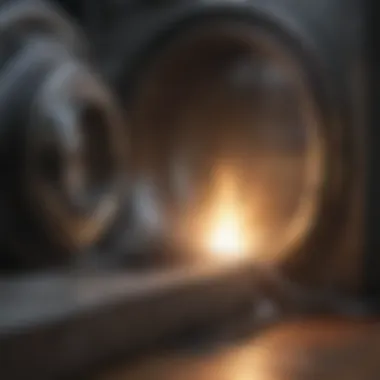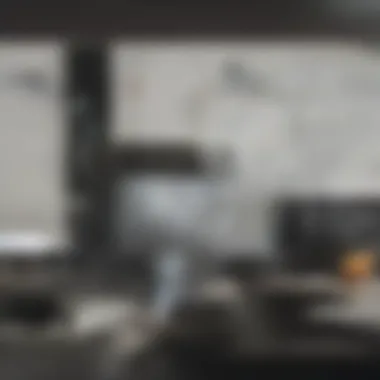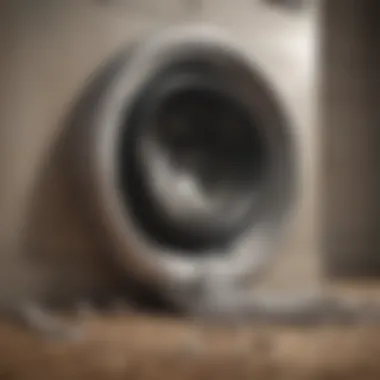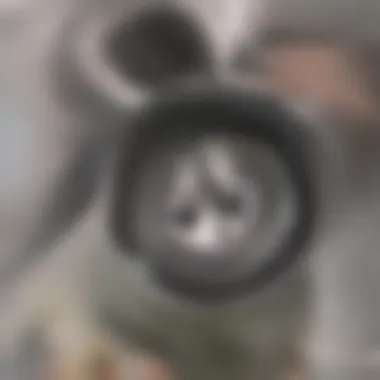A Complete Guide to Unplugging Your Dryer Vent Safely


Intro
Maintaining a clean and functional dryer vent is crucial for your home’s safety and efficiency. This guide will provide you with a thorough understanding of the steps involved in unplugging a dryer vent. Understanding how to safely disconnect your dryer from its vent system is essential, as it helps prevent hazards such as fire risks and operational inefficiencies. This process requires certain tools and awareness of common mistakes people make. By the end of this article, you will be well-prepared to tackle this important household task.
Importance of Dryer Vent Maintenance
Dryer vent maintenance cannot be overlooked. A clogged or damaged vent can lead to significant problems. Here are some key reasons why keeping your dryer vent clear is essential:
- Fire Hazard: Lint buildup can ignite and lead to fires, putting your home at risk.
- Increased Energy Bills: A blocked vent forces your dryer to work harder, increasing energy consumption.
- Longer Drying Times: Restricted airflow can mean that your clothes take longer to dry, causing frustration.
Tools Required
Having the right tools is essential for a successful dryer vent unplugging process. Here’s a list of items you will likely need:
- Screwdriver (typically Phillips or flathead)
- Adjustable wrench
- Vacuum cleaner with a hose attachment
- Wire brush or vent cleaning kit
- Safety goggles and gloves
Always ensure that you choose quality tools for the best results.
Common Pitfalls to Avoid
When unplugging a dryer vent, be aware of common mistakes that many individuals make. Avoid the following:
- Not disconnecting power: Failing to unplug the dryer can lead to electrical hazards.
- Ignoring lint buildup: If you see debris, do not assume it will clear out easily; address it directly.
- Neglecting proper sealing upon reconnection: This can lead to leaks, diminishing efficiency.
"Regular maintenance of your dryer vent not only ensures safety but also improves drying performance."
With the right preparation and attention to detail, you can effectively manage your dryer vent maintenance. This article will further elaborate on the steps involved, enhancing your understanding of this vital home maintenance task.
Understanding Dryer Vents
Dryer vents are crucial components of laundry appliances. They play a vital role in efficiently venting away hot, moist air produced during the drying process. When you comprehend how dryer vents function and their importance, you can ensure household safety and optimal dryer performance.
Definition and Purpose
A dryer vent, specifically, is a duct that carries moist air from your dryer to the outside of your home. It is generally made from flexible or rigid tubing. The purpose of this vent is to expel wet air and lint while preventing the accumulation of potentially harmful materials inside the vent. This is essential, as excess lint buildup can lead to serious fire hazards. The National Fire Protection Association (NFPA) notes that nearly 15,000 dryer fires occur annually, underscoring the significance of proper vent maintenance. Keeping your dryer vent clean and unplugged ensures not only that it functions correctly, but also that it complies with safety regulations.
How Dryer Vents Work
Understanding how dryer vents operate can demystify many issues related to dryer performance. When clothes dry, the heat from the dryer causes moisture to evaporate. This moisture-laden air needs a pathway to exit your home, and that is where the dryer vent comes into play.
When the dryer is active, a fan inside the appliance pushes this warm, wet air through the vent. The design of the vent is key; it should be straight and as short as possible to allow for efficient air movement. Any bends or excessive length can impede airflow, leading to less effective drying and increased risk of lint collection. If a vent is improperly installed or blocked, the dryer may overheat, requiring more time to dry clothes. In some cases, it might even stop working entirely.
Proper dryer vent installation and routine cleaning are fundamental to maintaining your dryer’s efficiency.
Knowing the basic functions and the potential risks associated with dryer vents lays a strong foundation. It encourages timely preventive measures, ensuring a safer and more energy-efficient laundry experience.
Why Unplugging a Dryer Vent is Necessary
Understanding the necessity of unplugging a dryer vent involves recognizing both safety and efficiency concerns. It is not merely a chore, but a fundamental step in maintaining a functional dryer system. Ignoring this task can lead to a range of problems, including fire hazards and poor dryer performance.
Safety Concerns
One of the primary reasons for unplugging a dryer vent is safety. Over time, lint and debris accumulate within the vent system. This buildup can significantly increase the risk of a fire. The National Fire Protection Association (NFPA) reports that failure to clean dryer vents is one of the leading causes of home fires. Regularly unplugging and cleaning the vent reduces this risk considerably.
To mitigate any hazards, it is advisable to perform this maintenance at least once a year. If your dryer often runs hot or takes longer than usual to dry clothes, it is a clear sign that the vent could be clogged. Monitoring these conditions is crucial for preventing potential dangers associated with dryer vent issues.
Efficiency Issues
Another critical reason to unplug a dryer vent concerns its efficiency. When the vent is blocked or partially obstructed, the dryer must work harder to expel moisture. This additional strain can lead to longer drying times, increased energy consumption, and potential wear on your dryer. The money spent on energy bills can add up fast if the dryer is not functioning optimally.


Furthermore, a blocked vent can lead to increased humidity levels in the laundry area, which may cause mold growth and other damage over time. By ensuring the vent is clean and unplugged regularly, you enhance the appliance's performance and protect your home from unintended moisture issues.
In summary, the necessity to unplug a dryer vent goes beyond mere maintenance. It's an essential practice for ensuring household safety and promoting energy efficiency.
Required Tools and Equipment
Understanding the necessary tools and equipment for unplugging a dryer vent is crucial for both safety and efficiency. Proper preparation can prevent accidents and ensure that the process runs smoothly. This section will explore the essential tools and safety gear required for this task, emphasizing their benefits and considerations.
Basic Tools
To unplug a dryer vent successfully, several basic tools are key. Having these tools on hand will make the task easier and more manageable. Here are the most important tools:
- Screwdriver: A standard screwdriver is essential for loosening screws that may be holding the vent connection in place. It’s important to know whether your dryer uses Phillips or flathead screws to have the right type ready.
- Pliers: Pliers will help to grip and pull apart stubborn vent hoses. They provide the necessary leverage when working with tight spaces.
- Putty Knife: For accessing hidden clips that hold the vent in position, a putty knife can be very handy. This thin tool allows you to maneuver into small crevices without damaging adjacent structures.
- Vacuum Cleaner: A vacuum cleaner with a hose attachment is useful for cleaning out any lint that may have accumulated in the vent system. This not only improves efficiency but also reduces fire hazards.
Having these tools can significantly streamline the process of unplugging your dryer vent.
Safety Gear
When working with appliances, safety should always be a priority. Certain safety gear is recommended to protect from potential hazards. Here’s what you need:
- Gloves: Wearing gloves protects your hands from sharp edges or debris that may be present when disconnecting the vent.
- Safety Goggles: Safety goggles shield your eyes from dust and lint that may be released during the unplugging process. It’s essential to maintain your vision while performing any repairs.
- Dust Mask: In case of excessive dust, wearing a dust mask prevents you from inhaling harmful particles that could affect your respiratory system.
By donning appropriate safety gear, you create a safer work environment which can lead to a more effective and hassle-free unplugging experience.
"Taking the time to prepare with the right tools and safety gear can save you from potential injuries and complications during the dryer vent unplugging process."
Preparing to Unplug the Dryer Vent
Preparing to unplug the dryer vent is a critical stage in the overall process of dryer maintenance. Engaging in careful preparation enhances safety, mitigates risks, and ensures that the task can be completed effectively and efficiently. It is not merely about detaching the vent but ensuring that all necessary precautions are taken. By properly preparing, you minimize the possibility of accidents, protect your equipment, and set the stage for a smooth working environment.
Turning Off the Dryer
Before performing any maintenance work, it is essential to turn off the dryer. This step is fundamental to avoid any electrical hazards. Ensure that the dryer is completely powered down, which usually means switching it off at the control panel and unplugging it from the outlet. This disconnection will remove any chance of the dryer operating unexpectedly while you are working on it.
Follow these steps to ensure the dryer is off:
- Locate the control panel.
- Set the dryer to the off position.
- Unplug the dryer from the wall outlet.
This process not only ensures your safety but also preserves the integrity of the appliance. Distractions can result in unintentional damage or injury. By following this protocol, you create a secure environment for the task ahead.
Clearing the Area
The area around the dryer should be clear of any obstructions before beginning the unplugging process. Clearing the space serves multiple purposes. Firstly, it allows easy access to the dryer and vent. Secondly, it reduces the risk of tripping or knocking into objects as you work. Additionally, a clean workspace contributes to a more organized and stress-free environment.
To prepare the area effectively, consider the following actions:
- Remove any items stored nearby such as laundry baskets, cleaning supplies, or other appliances.
- Sweep or vacuum the floor to ensure no dirt or debris interferes with your movements.
- Ensure good lighting in the workspace; this makes it easier to see what you are doing and reduces the likelihood of mistakes.
A clear and organized area not only improves safety but also enhances efficiency during the unplugging process.
By addressing these preparatory steps, you set yourself up for a successful and safe vent unplugging experience.
Step-by-Step Guide to Unplugging the Dryer Vent
Unplugging a dryer vent may seem como a simple task, but it plays a crucial role in ensuring safety and efficiency in your home. A well-maintained vent system prevents fire hazards and improves dryer performance. This section will guide you through the necessary steps to safely disconnect your dryer from its vent. Each step is essential, and attention to detail can make a significant difference in the process.
Locating the Vent Connection
The first step involves locating the vent connection. This connection is usually found at the back of the dryer, where the vent hose attaches. It is important to ensure you have a clear view of this area. Sometimes, there may be obstacles like furniture or storage items that can hinder access. A good practice is to move these items away before starting. Check for any spots where dust or lint might have accumulated, as this could indicate a buildup in the vent system.


Disconnecting the Vent Hose
After locating the vent connection, the next task is to disconnect the vent hose. Depending on your dryer model, this hose could be attached using clamps or screws. Make sure you have the proper tools ready, like a screwdriver or a wrench.
To disconnect:
- If it’s a clamp, push the ends to loosen it and slide the hose off.
- If it’s a screw, carefully unscrew them and gently pull the hose away from the vent.
Be cautious as you remove the hose; it can be dusty or dirty. Wear a mask to prevent inhalation of any particulates. This step is vital as it ensures that the flow of air from the dryer is not blocked during operation.
Removing the Vent Cap
Once you have disconnected the vent hose, the final step in this guide is to remove the vent cap from the exterior of your home. The cap serves to prevent debris and animals from entering the vent system while allowing air to escape. The cap can be secured by screws or clips, depending on the installation. Thus, a screwdriver may be required again here.
To remove the vent cap:
- Go outside to where the vent exits your home.
- Inspect the cap to check for the type of fastener.
- Carefully unscrew or unclip it and gently pull the cap away.
Removing the vent cap not only allows for cleaning and maintenance but also helps in assessing any damage that may have occurred over time.
This step brings you one step closer to ensuring that your dryer operates effectively and safely. Completing each of these tasks correctly will set you up nicely for follow-up maintenance activities, like inspecting and cleaning the vent system.
Common Challenges and Solutions
When unplugging a dryer vent, several challenges may surface. Understanding these challenges can help in developing effective solutions. Recognizing potential issues beforehand ensures that the process goes smoothly and efficiently. By addressing challenges, you not only save time but also avoid potential damages to your dryer or vent system.
Stubborn Vent Connections
Stubborn vent connections are a frequent issue faced during the disconnection of dryer vents. Over time, lint accumulation, heat exposure, and pressure can make these connections extremely tight. The first solution to this problem is to use a pair of pliers or a wrench gently. Applying steady pressure can loosen the connection. However, caution is paramount. You should avoid excessive force that might damage the vent or its attachment point on the dryer.
Sometimes, a lubricant like penetrating oil can facilitate the disconnection process. Apply a small amount to the seam between the vent hose and the dryer and allow it to penetrate for several minutes before attempting to disconnect again. This method often resolves stubborn connections without causing harm to any components.
Above all, patience is essential when dealing with this challenge. If a connection seems impossible to budge, consider reassessing to avoid breaking the vent. If you're still struggling, it may be beneficial to consult with a professional who specializes in dryer maintenance.
Damaged Vent Hoses
Another common challenge is handling damaged vent hoses. These hoses can develop cracks or holes over time, often due to wear and tear. Identifying the damage before attempting to unplug is crucial. Inspect the hose for any visible punctures or weak spots. If found, it is wise to replace the hose rather than continuing to use it.
To replace a damaged hose, begin by carefully detaching it from the dryer and the wall vent. Make sure to dispose of the damaged component properly. When installing a new hose, choose one that meets the correct length and specifications to ensure optimal functioning.
Another practical solution for slightly damaged hoses involves sealing the cracks with metallic tape. This temporary fix can extend the hose's life until you can replace it. However, this should not be seen as a long-term solution, as damaged hoses can lead to airflow issues or even pose a fire hazard.
It is essential to regularly inspect vent hoses to prevent issues that may arise from ongoing wear and tear.
Post Removal Considerations
Once the dryer vent is unplugged, it's crucial to take a moment to evaluate the entire vent system's condition. This process will not only ensure that your dryer operates efficiently but also mitigate fire hazards that come from lint buildup.
Inspecting the Vent System
When inspecting the vent system, begin by visually examining all accessible components. Look for any signs of damage, such as cracks in the ductwork or loose connections. A damaged vent can lead to reduced airflow, which can cause the dryer to overheat.
Check for lint accumulation, which is the main cause of dryer inefficiency and can increase fire risk. Use a flashlight if necessary to see into tight spaces. Ensure the vent is securely connected to the dryer and not allowing air to escape. If you notice any significant damage or excessive lint, it may be necessary to replace the affected sections or undertake a deeper cleaning.
Cleaning the Vent
Cleaning the vent is a critical task that should be performed regularly. A clean vent promotes better airflow and efficiency, reducing wear on your dryer and lowering energy bills.
To begin cleaning, use a vacuum cleaner with a long hose attachment to remove visible lint. If possible, use a vent cleaning tool designed specifically for dryer ducts. This tool can reach into bends and corners that a regular vacuum might miss.


- Remove the vent from the wall and the dryer.
- Insert the cleaning tool and rotate it to dislodge lint buildup.
- Repeat the process several times until the vent is free of debris.
- Pay close attention to the outdoor vent cap, as it can also collect lint and obstructions.
After cleaning, reconnect everything securely and do a final inspection to ensure all components are intact and clean. This preventative maintenance enhances dryer performance significantly.
"Regular inspection and cleaning of your dryer vent can prevent serious hazards while improving efficiency."
Taking these post-removal steps will help maintain the longevity of your dryer and ensure optimal operation.
Reconnecting the Vent: When and How
Reconnecting the dryer vent is a crucial step after performing maintenance or repairs. Ensuring the dryer vent is properly connected can significantly enhance dryer efficiency and reduce the risk of fire hazards. A well-functioning vent system prevents lint buildup and allows for optimal airflow, which is essential for safe and effective dryer operation.
When to Reconnect
Before reconnecting the vent, assess the circumstances that led to the disconnection. There are specific situations when a reconnection is necessary:
- After Cleaning: Following a thorough cleaning of the vent system to remove debris or lint.
- Post-Repairs: After fixing any damage to the vent or the dryer itself, to ensure proper function.
- New Installation: When setting up a new dryer in a space that requires venting.
Be sure to pay attention to the condition of the vent and the hose. If they show signs of significant wear or damage, consider replacement instead of reconnection.
Steps for Reconnection
Reconnecting the dryer vent involves a few essential steps. Careful execution is important to ensure that the system works as intended:
- Prepare the Area: Clear any clutter around the dryer and vent area. This increases ease of access and reduces trip hazards.
- Align the Vent Hose: Position the vent hose so it connects seamlessly to the dryer and the exterior vent. Check that it is not kinked or pinched.
- Secure the Connection: Use clamps or screws to attach the vent to both the dryer and the exhaust duct. Ensure the connections are tight to prevent air leaks.
- Test the Setup: Turn the dryer on to check for airflow. You should feel air moving at the vent exit. If there is little or no airflow, recheck all connections and adjustments.
- Final Check: Inspect the area for any lint or debris that might have come loose during the reconnection process. Cleaning up helps maintain a safer environment.
Proper reconnection of a dryer vent is essential for efficient operation and safety. Always ensure secure connections and perform regular checks for optimal performance.
By adhering to these guidelines, you can ensure your dryer operates efficiently, extending its life and maintaining safety in your home.
Preventative Maintenance Tips
Maintaining your dryer vent is crucial for both its efficiency and safety. Regular maintenance can prevent potential hazards like fires and ensure optimal performance. Ignoring this aspect could lead to increased energy bills and possible appliance damage. This section elaborates on the importance of preventative care specifically for dryer vents.
Regular Inspection Schedule
Establishing a routine inspection schedule for your dryer vent system will help in identifying issues early. Aim for at least bi-annual checks, but if you use your dryer heavily, quarterly inspections are advisable. During these inspections, look for lint buildup, which is the most common cause of inefficiency and hazards in dryer operations. Additionally, verify that the vent is securely attached and that there are no kinks or blockages.
Here are steps to consider when setting up a schedule:
- Choose a reminder system: Use a calendar app or a physical planner.
- Track usage: Note how often you use the dryer, as more frequent use requires closer monitoring.
- Use seasonal changes: Align inspections with changing seasons to help remember to check.
Signs of Dryer Trouble
Being vigilant about signs of dryer trouble can help you act before small issues lead to larger problems. These signs include:
- Increased drying times: If clothes take significantly longer to dry, the vent might be blocked.
- Burning smell: This could indicate overheating, powered by a blockage or lint buildup.
- Hot exterior: A dryer that feels excessively warm to the touch may have restricted airflow.
- Lint accumulation: Finding lint around the dryer, especially near ventilation, is a clear indication of an issue.
"Regular maintenance is not just about preventing breakdowns; it is about ensuring your appliance operates at its best."
Attending to these indicators promptly can enhance the longevity of your dryer and improve your overall laundry experience.
Ending
Summarizing Key Points
To recap, here are the critical points discussed:
- Definition and Purpose of Dryer Vents: Knowing their role in expelling moisture and lint is essential to prevent issues.
- Risks of Neglect: Unplugging regularly is needed to avoid safety hazards like fire and mechanical failures of the dryer itself.
- Required Tools: It is necessary to gather the right tools, including screwdrivers, safety gloves, and possibly a vacuum.
- Preparation Steps: Safe practices, such as turning off the dryer and clearing surrounding areas, were highlighted.
- Step-by-Step Disconnection: The detailed guide provided clear instructions on locating and disconnecting the vent hose.
- Post Removal and Maintenance: Cleaning the vent after unplugging ensures that your appliance runs optimally.
This thorough overview aids in grasping the entire process and its implications.
Final Recommendations
- Frequent Checks: Schedule regular inspections of dryer vents for blockages. This prevents future complications and keeps your dryer operating efficiently.
- Understand the Signs: Awareness of signs indicating potential dryer trouble, like longer drying times or a burning smell, can prompt timely action.
- Seek Professional Help: If difficulties arise during the unplugging process, do not hesitate to consult a professional. Their expertise can be invaluable.
By following these guidelines and recommendations, you will improve both your dryer’s function and overall safety in your home. Prioritizing dryer maintenance is not just a task but an investment in your health, safety, and appliance longevity.















